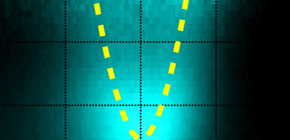
Electron’s 1D metallic surface state observed for the first time
A step toward the prediction of properties of extremely-fine metal nanowires in next-generation semiconductors
In the one-dimensional (1D) nanospace, various phenomena are predicted that are totally different from those in the 3D world in which we live. One of the reasons for this is that particles cannot pass each other in 1D. (Fig. 1)
A Japan-France joint research group artificially created such unique 1D nano electronic systems on the surface of a solid, observed the state and movement of electronics (energy and kinetic momentum) using light, and verified the electronic structure (electronic behavior). This group’s research will help elucidate the mystery of unique electronic properties of 1D nano metals and provide, for example, information helpful for the prediction of electrons expressed in extremely fine metal nanowires used in next-generation semiconductor devices.
A group of researchers led by OHTSUBO Yoshiyuki (Assistant Professor) and KIMURA Shin-ichi (Professor) of the Graduate School of Frontier Biosciences, Osaka University, TANAKA Kiyohisa (Associate Professor) of the Institute for Molecular Science, and Amina Taleb (Professor) of Synchrotron SOLEIL, France, artificially created Tomonaga-Luttinger liquid (TLL) on the surface of a semiconductor crystal. TLL is a state in which electrons move not as individuals, but as a group, and the movements of spin and charge appear separately. This state is totally different from the normal state of electrons in metal.
Using angular-resolved photoemission spectroscopy, a method for observing kinetic momentum and binding energy of electrons in solid by shedding light on solid and observing the angle and energy of emitted electrons, this group elucidated the electrons’ state and movement in a wide scope of energy for the first time.
The 1D surface nanostructure discovered by this group, through the determination of detailed atomic structure and comparison with theoretical computation, will develop research on 1D nano-metallic electronic state, which had not been well known to this point due to shortage of experimental data.
As the understanding of the uniqueness of 1D nano metals is essential for predicting electronic properties of extremely fine metal nanowires in next-generation semiconductor devices, further development of this research is highly anticipated.
Abstract
A 1D metallic surface state was created on an anisotropic InSb(001) surface covered with Bi. Angle-resolved photoelectron spectroscopy (ARPES) showed a 1D Fermi contour with almost no 2D distortion. Close to the Fermi level ( E F ), the angle-integrated photoelectron spectra showed power-law scaling with the binding energy and temperature. The ARPES plot above E F , obtained thanks to a thermally broadened Fermi edge at room temperature, showed a 1D state with continuous metallic dispersion across E F and power-law intensity suppression around E F . These results strongly suggest a Tomonaga-Luttinger liquid on the Bi / InSb ( 001 ) surface.
Figure 1
Figure 2
To learn more about this research, please view the full research report entitled " Surface Tomonaga-Luttinger-Liquid State on Bi/InSb(001) " at this page of the Physical Review Letters website.
Related link
